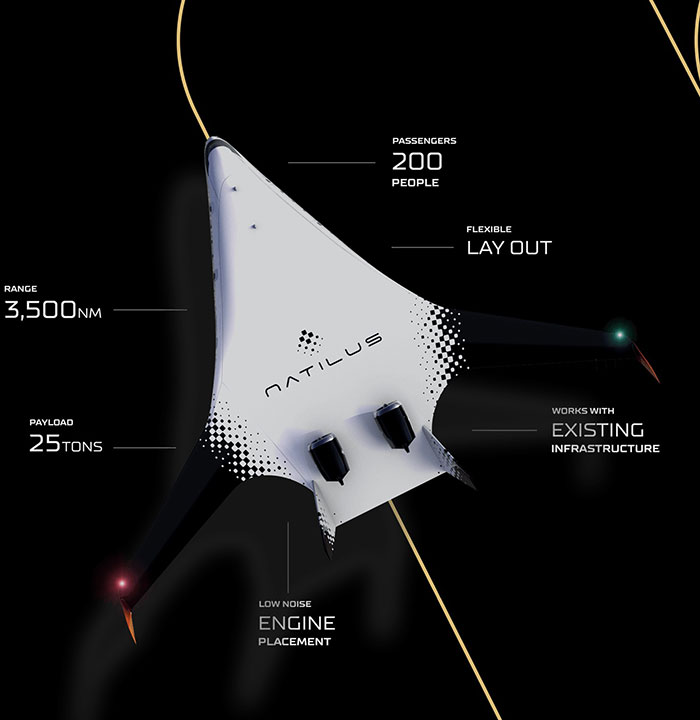10 Game-Changing Innovations in Blended-Wing Aircraft Set to Redefine Luxury Air Travel
- 2nd Nov 2024
- 1398
- 0

Aviation’s Rising Emissions and Need for Innovation
With the surge in global air travel, aviation emissions have climbed faster than those from road, rail, or shipping, placing the industry under pressure to find sustainable solutions.
While Sustainable Aviation Fuel (SAF) offers hope, capable of reducing flight emissions by 80% under optimal conditions, its limited supply means it only accounts for 0.53% of global jet fuel usage in 2024.
As such, alternative designs like the blended-wing body are drawing attention as innovative solutions to lower emissions and redefine the aviation experience.
Reimagining Aircraft Design: The Blended-Wing Body
A departure from the classic “tube and wing” design that has shaped commercial aviation for over a century, the blended-wing body merges the wings with the fuselage, creating a sleek, cohesive structure. This distinct design promises a 30% fuel efficiency boost, aligning well with the industry's push for sustainability and potentially marking a new era in luxury air travel. By reducing drag and optimizing aerodynamics, this design could significantly cut fuel use and emissions while offering a stylish, futuristic look.
Leading the Way: Airbus and JetZero’s Early Ventures
In 2020, Airbus launched a small, remote-controlled prototype of a blended-wing aircraft, demonstrating the design’s potential to save up to 20% on fuel. JetZero, a California-based company, followed suit in 2023, unveiling plans for a similar model capable of carrying over 200 passengers. Both companies aim to introduce these models to the market by 2030, showcasing the blended-wing body’s promise as an effective solution for large-scale sustainable aviation.
Natilus Enters the Market with Horizon’s Ambitious Goals
San Diego-based Natilus is now competing with a blended-wing model named Horizon, designed to carry around 200 passengers. The company claims Horizon could use 30% less fuel and produce half the emissions of current Boeing 737 and Airbus A320 models. CEO Aleksey Matyushev noted that Horizon is poised to meet the demands of the narrow-body market, predicted to dominate over the next 20 years.
Addressing Stability: Aerodynamic Solutions over Complex Systems
The blended-wing body concept, initially explored by McDonnell Douglas in the 1990s, faced challenges in stability and control, which Natilus now aims to overcome through aerodynamics rather than relying on complex flight control systems. This approach differentiates Natilus from competitors and avoids the issues that plagued Boeing’s 737 Max model, where computer-controlled stability systems led to operational problems.
Luxury in the Skies: Expansive Cabin for Elevated Passenger Experience
Beyond efficiency, the blended-wing design offers an expansive cabin that is about 30% larger than conventional aircraft, opening possibilities for an elevated passenger experience. Natilus envisions a future where luxury elements like in-flight lounges and relaxation spaces for long-haul flights redefine comfort, bringing back the glamour of commercial air travel and attracting a high-end market.
Designed for Compatibility: Leveraging Existing Airport Infrastructure

To minimize operational risks, Horizon will utilize proven engine technology and be compatible with existing airport facilities, fitting wherever a Boeing 737 or Airbus A320 would. This approach allows the model to integrate into current infrastructure, enhancing its appeal to airlines wary of investing in specialized equipment or new procedures.
Challenges to Entry: Crew Training and Regulatory Hurdles
Aviation analyst Gary Crichlow notes that although current delays in aircraft deliveries create a window for new players, Natilus will face challenges in training flight and cabin crews, as well as adapting airport services for the unique design. Regulatory approval is another major hurdle, with the unconventional blended-wing body likely undergoing additional scrutiny during certification.
Prototype Development: Preparing the Blended-Wing for Commercial Scale
Natilus is currently working on a full-scale prototype, addressing vital questions around the practical application of the blended-wing body at a commercial scale. Matyushev is aware of the challenges ahead, yet confident that Natilus is on track to answer these questions and lead the industry into new, uncharted territory.
A Sustainable and Luxurious Future in Aviation
For luxury air travelers, Natilus’s Horizon represents a promising shift toward an aviation future that blends sustainability with an enhanced onboard experience. With reduced environmental impact, spacious interiors, and refined aesthetics, the blended-wing body is set to cater to discerning passengers looking for both comfort and a commitment to sustainability in their travels.
 Pradeep Dhuri
Pradeep Dhuri


Comments
No comments yet.
Add Your Comment
Thank you, for commenting !!
Your comment is under moderation...
Keep reading luxury post